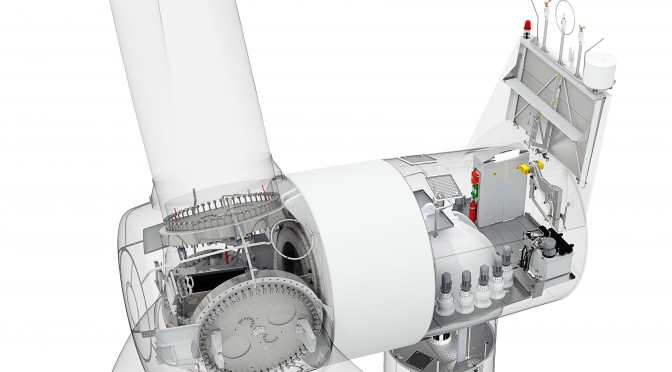Today, Siemens has announced its decision to invest £160 million (EUR190m) in wind turbine production and installation facilities in Yorkshire. The revised plan will be spread across two sites comprising the previously announced Green Port Hull project construction, assembly and service facility and a new rotor blade manufacturing facility in nearby Paull, in East Riding. Siemens is investing £160 million across the two locations and its port partner Associated British Ports (ABP) is investing a further £150 million in the Green Port Hull development. The investment will provide a huge boost to the UK’s offshore wind industry and the Humber region. The combined investments of £310 million will create up to 1,000 jobs directly, with additional jobs during construction and indirectly in the supply chain.
Prime Minister David Cameron said:
“This is a massive vote of confidence in our long-term economic plan. This investment is going to create lots of new jobs and opportunities, meaning more financial security and peace of mind for families and a more resilient economy for our country.”
The Green Port Hull project has been in the making for around four years and is the product of a huge team effort between many national and local political, business and community parties and many people within Siemens in the UK, Denmark and Germany, and ABP.
The much anticipated investment is a landmark moment for the UK offshore wind industry. It is the first manufacturing plant of its kind for Siemens next generation blade technology (IntegralBlade®) designed for Siemens SWT-6.0-154 6 megawatt (MW) wind turbine. This is leading edge technology – each rotor blade is 75 metres long and when rotating covers an area the size of two and a half football pitches.
“Our decision to construct a production facility for offshore wind turbines in England is part of our global strategy: we invest in markets with reliable conditions that can ensure that factories can work to capacity. The British energy policy creates a favourable framework for the expansion of offshore wind energy. In particular, it recognizes the potential of offshore wind energy within the overall portfolio of energy production,” stated Michael Suess, member of the managing board of Siemens AG and CEO of the Energy Sector. The offshore wind market in Great Britain has high growth rates, with an even greater potential for the future. Wind power capacity has doubled here within two years, to roughly 10 gigawatts. By 2020, a capacity of 14 gigawatts is to be installed at sea alone to combine the country’s environmental objectives with secure power supply. Projects for just over 40 gigawatts are currently in the long-term planning.”
Energy Secretary Ed Davey said:
“This deal is excellent news for the people of Hull and the Humber, the UK, the wind industry, and our energy security. We are attracting investment by backing enterprise with better infrastructure and lower taxes. As well as helping to keep the lights on and putting more than 1,000 people in work, this deal means we will help to keep consumer bills down as we invest in home-grown green energy and reduce our reliance on foreign imports.
“This deal shows our strategy for offshore wind is working; bringing investment, green jobs and growth, and helping keep Britain the number one country in the world for offshore wind.”
Roland Aurich, Chief Executive, Siemens plc said:
“Being able to further increase our presence in the UK with this significant commitment is great for Siemens, for the UK economy and for future generations, who will benefit from more secure and sustainable, low carbon energy.”
Matthew Chinn, Managing Director of Siemens Energy UK & Ireland said:
“Siemens is a leader in offshore wind and the investment demonstrates our ongoing commitment to UK manufacturing and confidence in the industry. The development of local manufacturing will provide a huge boost to the UK renewables industry and will help unlock other major projects and investments.”
Green Port Hull is also a landmark moment for the Humber region, promising regeneration and the creation of many hundreds of new jobs and new skills.
Siemens manufacturing plans will help create around 1,000 jobs – 550 at the blade factory and 450 at Green Port Hull. This is a welcome boost to the economy and to Hull which will be City of Culture in 2017 when the factory will be up and running.
James Cooper, ABP Chief Executive said: “The announcement by Siemens today underlines the critical role the Humber region plays in servicing the UK’s energy needs, both today and in the future. Our investment in Green Port Hull will ensure the supply chain supporting this exciting new industry can be centred on the Humber. We are delighted that Siemens has chosen to partner with us to realise this exciting project.”
Siemens and ABP will be submitting planning applications to Hull City Council and East Riding Council over the next few months for revisions to the existing proposed scheme at Alexandra Dock and for land in Paull in East Riding for the wind turbine blade factory.
Green Port Hull is planned to be operational to meet Round 3 requirements in early 2016. The start of production at the blade factory is scheduled to be in the middle of 2016 with full production levels reached from mid 2017 onwards.
Siemens in the UK
Siemens was established in the United Kingdom 170 years ago and now employs 13,760 people in the UK. Last year’s revenues were £3.36 billion*. As the world’s largest engineering company, Siemens provides innovative solutions to help tackle the world’s major challenges across the key sectors of energy, industry, infrastructure & cities and healthcare. Siemens has offices and factories throughout the UK, with its headquarters in Frimley, Surrey. The company’s global headquarters is in Munich, Germany.
http://santamarta-florez.blogspot.com.es/2014/03/siemens-to-build-major-offshore-wind.html


